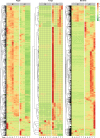Associated bacterial microbiome responds opportunistic once algal host Scenedesmus vacuolatus is attacked by endoparasite Amoeboaphelidium protococcarum
- PMID: 35915148
- PMCID: PMC9343445
- DOI: 10.1038/s41598-022-17114-1
Associated bacterial microbiome responds opportunistic once algal host Scenedesmus vacuolatus is attacked by endoparasite Amoeboaphelidium protococcarum
Abstract
The interactions of microalgae and their associated microbiomes have come to the fore of applied phycological research in recent years. However, the functional mechanisms of microalgal interactions remain largely unknown. Here, we examine functional protein patterns of the microalgae Scenedesmus vacuolatus and its associated bacterial community during algal infection by the endoparasite Amoeboaphelidium protococcarum. We performed metaproteomics analyses of non-infected (NI) and aphelid-infected (AI) S. vacuolatus cultures to investigate underlying functional and physiological changes under infectious conditions. We observed an increase in bacterial protein abundance as well as a severe shift of bacterial functional patterns throughout aphelid-infection in comparison to NI treatment. Most of the bacterial proteins (about 55%) upregulated in AI were linked to metabolism and transport of amino acids, lipids, coenzymes, nucleotides and carbohydrates and to energy production. Several proteins associated with pathogenic bacterial-plant interactions showed higher protein abundance levels in AI treatment. These functional shifts indicate that associated bacteria involved in commensalistic or mutualistic interactions in NI switch to opportunistic lifestyles and facilitate pathogenic or saprotrophic traits in AI treatment. In summary, the native bacterial microbiome adapted its metabolism to algal host die off and is able to metabolize nutrients from injured cells or decompose dead cellular material.
© 2022. The Author(s).
Conflict of interest statement
The authors declare no competing interests.
Figures






Similar articles
-
Physiological and Dual Transcriptional Analysis of Microalga Graesiella emersonii-Amoeboaphelidium protococcarum Pathosystem Uncovers Conserved Defense Response and Robust Pathogenicity.Int J Mol Sci. 2021 Nov 27;22(23):12847. doi: 10.3390/ijms222312847. Int J Mol Sci. 2021. PMID: 34884652 Free PMC article.
-
A new isolate of Amoeboaphelidium protococcarum, and Amoeboaphelidium occidentale, a new species in phylum Aphelida (Opisthosporidia).Mycologia. 2015 May-Jun;107(3):522-31. doi: 10.3852/14-064. Epub 2015 Feb 6. Mycologia. 2015. PMID: 25661716
-
Characterization of Amoeboaphelidium protococcarum, an algal parasite new to the cryptomycota isolated from an outdoor algal pond used for the production of biofuel.PLoS One. 2013;8(2):e56232. doi: 10.1371/journal.pone.0056232. Epub 2013 Feb 20. PLoS One. 2013. PMID: 23437098 Free PMC article.
-
Impact of Microalgae-Bacteria Interactions on the Production of Algal Biomass and Associated Compounds.Mar Drugs. 2016 May 19;14(5):100. doi: 10.3390/md14050100. Mar Drugs. 2016. PMID: 27213407 Free PMC article. Review.
-
The use of natural infochemicals for sustainable and efficient harvesting of the microalgae Scenedesmus spp. for biotechnology: insights from a meta-analysis.Biotechnol Lett. 2016 Dec;38(12):1983-1990. doi: 10.1007/s10529-016-2192-2. Epub 2016 Aug 26. Biotechnol Lett. 2016. PMID: 27565669 Free PMC article. Review.
Cited by
-
Unravelling microalgal-bacterial interactions in aquatic ecosystems through 16S rRNA gene-based co-occurrence networks.Sci Rep. 2023 Feb 16;13(1):2743. doi: 10.1038/s41598-023-27816-9. Sci Rep. 2023. PMID: 36797257 Free PMC article.
-
Disentangling direct vs indirect effects of microbiome manipulations in a habitat-forming marine holobiont.NPJ Biofilms Microbiomes. 2024 Mar 29;10(1):33. doi: 10.1038/s41522-024-00503-x. NPJ Biofilms Microbiomes. 2024. PMID: 38553475 Free PMC article.
-
Importance, structure, cultivability, and resilience of the bacterial microbiota during infection of laboratory-grown Haematococcus spp. by the blastocladialean pathogen Paraphysoderma sedebokerense: evidence for a domesticated microbiota and its potential for biocontrol.FEMS Microbiol Ecol. 2025 Jan 28;101(2):fiaf011. doi: 10.1093/femsec/fiaf011. FEMS Microbiol Ecol. 2025. PMID: 39832809 Free PMC article.
-
Microbial Diversity and Community Structure of Wastewater-Driven Microalgal Biofilms.Microorganisms. 2023 Dec 16;11(12):2994. doi: 10.3390/microorganisms11122994. Microorganisms. 2023. PMID: 38138138 Free PMC article.
References
-
- Borowitzka M. Commercial-Scale Production of Microalgae for Bioproducts. In: La Barre S, Bates SS, editors. Blue Biotechnology. Wiley; 2018. pp. 33–65.
-
- Hallmann A, Rampelotto PH. Grand Challenges in Algae Biotechnology. Springer International Publishing; 2019.
-
- Araújo R, et al. Current status of the algae production industry in Europe: An emerging sector of the blue bioeconomy. Front. Mar. Sci. 2021 doi: 10.3389/fmars.2020.626389. - DOI
Publication types
MeSH terms
LinkOut - more resources
Full Text Sources

